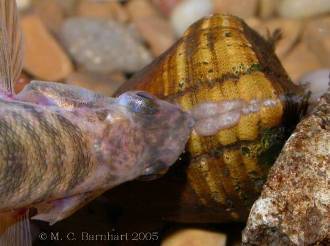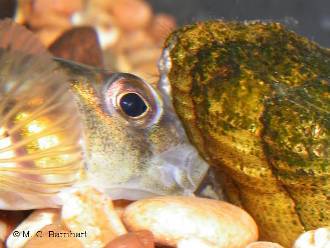Threatened and endangered species feature: snuffbox mussel, the rock monster
Michigan Department of Natural Resources sent this bulletin at 08/11/2014 03:35 PM EDT|
Learn more about this fascinating mussel in danger of becoming extinct. |
 |
 |
 |
 |
 |
Wildlife Viewing
The rock monster
 Aug. 11, 2014
Aug. 11, 2014
Through generous support from DTE Energy, the DNR is celebrating the 40th anniversary of Michigan’s Endangered Species Act from now through September. Each week, an important species will be featured.
And she waits.
She moves a bit and then waits.
Blind and hoping.
Bump.
Another bump.
Grab, and she’s got it!
She clamps down on his head good and tight.
Her young fly.
She releases and her unsuspecting victim swims away.
And she waits.
 The snuffbox mussel is inconspicuous, yet in many ways is a lie-in-wait predator. But instead of eating her prey, she uses the unsuspecting victim as host to her young. Mussels have a fascinating life history. Mussel babies, called glochidia, need to attach to the gills or fins of a specific type of fish to complete their life cycle. Snuffbox moms with babies sit in the bottom of a stream with their shells open somewhat to display their mantle (their fleshy body inside the shell). A fish swimming by will see that nice, soft flesh and think it’s a free meal. The fish will swim down and try to take a bite of the mussel’s mantle. Once the snuffbox feels the fish poke it, it grabs on to the fish's head – for the snuffbox the particular fish host is a logperch. Mussels don’t have eyes, so it is purely by feel that the mussel grabs the fish. The mom snuffbox then shoots her microscopic glochidia at the fish’s head so that her young can attach to its gills. The glochidia mature within a few weeks and then drop off the host fish and live out the rest of their life on the stream bottom among the rocks. The glochidia don’t hurt the fish, and the process provides a great way for mussels to move away from their parents – it’s a free ride out of town.
The snuffbox mussel is inconspicuous, yet in many ways is a lie-in-wait predator. But instead of eating her prey, she uses the unsuspecting victim as host to her young. Mussels have a fascinating life history. Mussel babies, called glochidia, need to attach to the gills or fins of a specific type of fish to complete their life cycle. Snuffbox moms with babies sit in the bottom of a stream with their shells open somewhat to display their mantle (their fleshy body inside the shell). A fish swimming by will see that nice, soft flesh and think it’s a free meal. The fish will swim down and try to take a bite of the mussel’s mantle. Once the snuffbox feels the fish poke it, it grabs on to the fish's head – for the snuffbox the particular fish host is a logperch. Mussels don’t have eyes, so it is purely by feel that the mussel grabs the fish. The mom snuffbox then shoots her microscopic glochidia at the fish’s head so that her young can attach to its gills. The glochidia mature within a few weeks and then drop off the host fish and live out the rest of their life on the stream bottom among the rocks. The glochidia don’t hurt the fish, and the process provides a great way for mussels to move away from their parents – it’s a free ride out of town.
To watch this very cool behavior in action and other cool videos, check out: http://unionid.missouristate.edu/gallery/Epioblasma/gallery_snuffbox_1.wmv http://unionid.missouristate.edu/gallery/Epioblasma/
 The snuffbox (Epioblasma trquetra) is a remarkable mussel that is in danger of becoming extinct. Unfortunately there are many threats to this species. Dams affect their ability to move both upstream and downstream, which can isolate populations. Mussels live most of their lives in a very small area, so toxins and poor water quality can easily harm them. Invasive species have also played a role in the decline of snuffbox. Zebra mussels often use any hard surface to attach to, including native mussels like the snuffbox, which end up suffocating because they can’t open their shells.
The snuffbox (Epioblasma trquetra) is a remarkable mussel that is in danger of becoming extinct. Unfortunately there are many threats to this species. Dams affect their ability to move both upstream and downstream, which can isolate populations. Mussels live most of their lives in a very small area, so toxins and poor water quality can easily harm them. Invasive species have also played a role in the decline of snuffbox. Zebra mussels often use any hard surface to attach to, including native mussels like the snuffbox, which end up suffocating because they can’t open their shells.
Snuffbox mussels, considered endangered in Michigan, were recently listed as federally endangered. This species is an indicator of health for many other species as well as their habitats. Work is needed to help protect this little rock monster.
How can you help the snuffbox?
There are several easy ways you can celebrate the 40th anniversary of Michigan's Endangered Species Act while helping to conserve the snuffbox and our state's other freshwater mussels and their fragile living spaces:
-
Become part of your local watershed group.
For more information on Michigan's threatened and endangered species and the 40th-anniversary celebration, visit www.michigan.gov/wildlife.